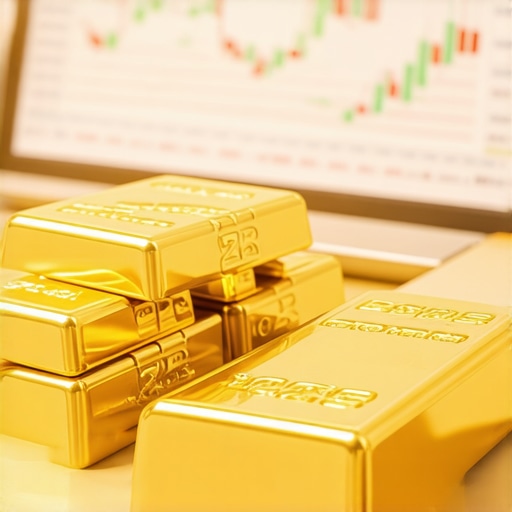Understanding Gold’s Role in Inflationary Times
As we look towards 2025, many investors are turning their attention to gold as a potential hedge against inflation. The economic landscape is constantly changing, and with inflation rates surging in recent years, the appeal of gold has never been more pronounced. Historically, gold has served as a safe haven asset, providing stability when other investments falter. This article examines the predictions for gold’s performance as a hedge against inflation in the coming years.
The Economic Landscape in 2025
To understand how gold can serve as a hedge against inflation, it’s essential to consider the broader economic factors at play. Economic indicators such as interest rates, inflation rates, and geopolitical tensions can significantly impact gold prices. In 2025, many analysts predict that inflation will remain a significant concern for investors. With the Federal Reserve and other central banks potentially raising interest rates to combat inflation, the dynamics of supply and demand for gold will shift.
As inflation rises, the purchasing power of fiat currencies may decrease, prompting investors to seek alternatives. This is where gold shines. Investors often flock to gold during inflationary periods as it retains intrinsic value. According to experts, the demand for gold could increase significantly in 2025, making it a critical asset for those looking to preserve wealth.
Gold vs. Other Investment Vehicles
When considering gold as a hedge against inflation, it’s crucial to compare it with other investment vehicles, such as stocks and real estate. Many investors wonder, is gold a better investment than stocks? While stocks can offer higher returns, they also come with increased volatility. In contrast, gold provides a more stable investment, especially during economic downturns.
Furthermore, the diversification benefits of including gold in an investment portfolio are well-documented. By balancing stocks, bonds, and gold, investors may achieve better overall portfolio performance. For those interested in maximizing returns, understanding the role of gold in portfolio diversification is vital.
Predictions for Gold Prices in 2025
Looking ahead, predictions for gold prices in 2025 suggest a bullish outlook. Analysts believe that as inflation persists, gold prices could rise significantly. Factors such as increased demand from emerging markets and continued interest from central banks in gold accumulation will contribute to this bullish sentiment. Additionally, geopolitical uncertainties, such as trade tensions and conflicts, often drive investors toward gold.
In light of these factors, understanding key factors influencing gold price dynamics will be crucial for investors. Keeping an eye on market trends and economic indicators will help investors make informed decisions regarding their gold investments.
Strategies for Investing in Gold
For those considering investing in gold as a hedge against inflation, developing a sound strategy is essential. Whether through physical gold, ETFs, or mining stocks, having a clear plan can optimize returns. For example, understanding gold ETFs can provide a more liquid and convenient way to invest in gold while mitigating some risks associated with physical ownership.
Ultimately, as we approach 2025, the predictions for gold’s role as a hedge against inflation will continue to evolve. By staying informed and understanding the intricacies of the gold market, investors can position themselves to make the most of this timeless asset.
Understanding Gold Investment Strategies for Inflationary Times
As we anticipate the economic landscape of 2025, it becomes increasingly essential for investors to consider tailored strategies for investing in gold. With inflation persisting as a significant concern, understanding effective strategies for gold trading can provide a competitive edge. Investors must evaluate various avenues such as physical gold, gold ETFs, and mining stocks to optimize their portfolios.
Physical Gold: A Tangible Asset
Investing in physical gold, whether it be bullion, coins, or jewelry, offers a tangible asset that can provide a sense of security during inflationary periods. One of the primary advantages of physical gold is its intrinsic value, which tends to remain stable even when fiat currencies fluctuate. However, it’s important to consider the costs associated with storage and insurance, which can impact overall returns. For those looking to understand the nuances of buying gold smartly, researching these factors is crucial.
Gold ETFs: A Flexible Investment Option
Exchange-Traded Funds (ETFs) represent a more liquid and convenient method for investing in gold. They allow investors to gain exposure to gold prices without the need for physical storage. Understanding gold ETFs can be especially beneficial for those who are new to the market. As we approach 2025, the demand for gold ETFs is likely to rise, presenting potential investment opportunities.
Gold Mining Stocks: An Alternative Investment Path
Another avenue to explore is investing in gold mining stocks. These stocks can provide leveraged exposure to gold prices, often outperforming physical gold during bull markets. However, investing in mining stocks also carries additional risks, including operational challenges and management decisions. To navigate this space effectively, investors should focus on understanding successful investing in gold mining stocks to mitigate risks while maximizing potential returns.
Market Trends Influencing Gold Demand
As we look toward 2025, several key market trends are expected to influence gold demand significantly. Geopolitical tensions and economic instability often compel investors to seek refuge in gold, driving up its price. Furthermore, the increasing interest from central banks in accumulating gold reserves is a trend that shouldn’t be overlooked. As central banks diversify their portfolios, understanding how central bank gold purchases affect prices can provide valuable insights for investors.
Emerging Markets and Gold Demand
Emerging markets are expected to play a pivotal role in the future of gold demand. As economies in countries like India and China continue to grow, their demand for gold for both investment and jewelry purposes is likely to increase. This trend highlights the importance of staying informed about global gold consumption patterns, as they can directly impact prices. Investors should consider how gold demand trends may evolve as we approach 2025.
Technological Advances and Gold Trading
The rise of digital platforms for trading gold has also transformed the investment landscape. These platforms provide greater accessibility and transparency, making it easier for new investors to enter the market. Understanding the basics of gold trading in this digital age is essential for those looking to capitalize on new opportunities as they arise. As we move forward, it will be crucial to keep an eye on how technology continues to shape the gold investment landscape.
The Impact of Geopolitical Events on Gold Prices
As we approach 2025, understanding the relationship between geopolitical events and gold prices becomes increasingly important for investors. Gold has historically been viewed as a safe haven during times of political and economic uncertainty. Events such as trade disputes, military conflicts, or changes in government can prompt a surge in gold demand. For instance, recent tensions between major economies have already led investors to seek refuge in gold. By staying informed about analyzing gold market trends, investors can better understand how to position their portfolios in response to these external pressures.
Gold as a Hedge Against Currency Fluctuations
Another critical factor to consider is how fluctuations in major currencies impact gold prices. As currencies like the US dollar fluctuate, gold often moves inversely. In periods of dollar weakness, gold tends to rise as it becomes cheaper for foreign investors. Understanding how gold serves as a hedge against currency fluctuations can help investors make more informed decisions regarding their gold investments. Keeping track of currency trends is essential for anticipating potential movements in gold prices.
Technological Innovations in Gold Investment Platforms
The evolution of technology has also played a significant role in shaping the gold investment landscape. Digital trading platforms have made it easier for investors to buy and sell gold, facilitating quicker transactions and improved market access. Understanding the basics of gold trading in this modern context is essential for both new and seasoned investors alike. These platforms often provide analytical tools and resources that can enhance investment strategies and decision-making processes.
Environmental and Ethical Considerations in Gold Mining
As environmental concerns continue to rise, investors are increasingly interested in the sustainability practices of gold mining companies. Ethical investing has gained traction, with many investors seeking to align their portfolios with their values. Understanding the implications of evaluating gold mutual funds that prioritize sustainable practices can provide a more comprehensive view of potential investments. Companies that focus on environmentally friendly practices may not only appeal to socially conscious investors but can also mitigate risks associated with regulatory changes and public opinion shifts.
Gold Investment Strategies for Different Market Conditions
Investing in gold requires a flexible strategy that can adapt to changing market conditions. For instance, during periods of economic growth, investors might consider increasing their allocation to gold mining stocks, as these can offer higher returns compared to physical gold. Conversely, in times of economic downturn, physical gold may provide more stability. Understanding maximizing returns with gold mining stocks can be crucial for investors looking to navigate different market scenarios effectively. Tailoring strategies to fit the current economic climate is essential for optimizing returns.
Global Demand for Gold: Trends to Watch
As we look towards 2025, global demand for gold is expected to evolve significantly. Emerging markets, particularly in Asia, are likely to play a pivotal role in shaping demand. Countries such as China and India have a rich cultural affinity for gold, and as their economies continue to grow, so too does their demand for gold. Investors should keep an eye on gold demand trends in these regions, as they can provide insight into potential price movements and market dynamics. Understanding these patterns can help investors make informed decisions about their gold investments moving forward.
Evaluating Gold Stocks vs. Other Investment Options
As gold continues to capture the attention of investors, evaluating gold stocks in comparison to other investment options becomes paramount. Gold stocks can offer significant leverage against gold price movements, presenting a unique opportunity for those looking to maximize returns. However, potential investors should weigh the risks and rewards associated with these stocks, especially in light of market volatility.
Understanding Market Sentiment and Gold Prices
Market sentiment plays a crucial role in shaping gold prices. Factors such as investor psychology, economic forecasts, and global events can significantly influence demand for gold. Staying informed about analyzing gold market trends is essential for making informed decisions. In 2025, as geopolitical tensions escalate, the demand for gold may surge, reflecting its status as a safe haven.
Gold Mutual Funds: A Diversified Approach
For those seeking a diversified investment approach, gold mutual funds represent an attractive option. These funds pool investors’ money to invest in a variety of gold-related assets, reducing individual risk. Understanding gold mutual funds can help investors navigate asset allocation strategies effectively. In times of uncertainty, these funds can provide stability and exposure to the gold market without the need for direct ownership of physical assets.
Long-Term vs. Short-Term Gold Investment Strategies
When investing in gold, it is essential to consider your investment horizon. Long-term investors often focus on the overall trend of gold prices, while short-term traders may capitalize on price fluctuations. Understanding how to maximize profits with gold trading techniques can empower investors to take advantage of market changes. A well-defined strategy tailored to your investment goals is crucial for success.
Monitoring Economic Indicators
Investors should also pay attention to economic indicators that can impact gold prices. Inflation rates, interest rates, and employment statistics are just a few factors that can influence market dynamics. Keeping track of key factors influencing gold price dynamics will be essential for making timely investment decisions. In 2025, adapting your strategy based on these indicators can enhance your portfolio’s performance.
Gold’s Role in a Balanced Investment Portfolio
Incorporating gold into a balanced investment portfolio can offer various benefits beyond mere appreciation. Gold serves as a hedge against inflation and currency fluctuations, providing a cushion during market downturns. Understanding the role of gold in a diversified investment portfolio can help investors achieve greater stability and long-term growth.
Conclusion: Preparing for Gold Investment in 2025
As we approach 2025, the landscape for gold investment continues to evolve. By understanding the intricacies of the gold market, analyzing trends, and developing sound investment strategies, investors can position themselves for success. Whether through gold stocks, mutual funds, or physical gold, a well-rounded approach to gold investment can enhance overall portfolio performance and resilience against economic fluctuations.
Frequently Asked Questions About Investing in Gold
What is the best way to invest in gold for beginners?
For beginners, the best way to invest in gold is through gold ETFs or mutual funds. These options provide exposure to gold prices without the complexities of physical ownership. Additionally, investing in reputable gold mining stocks can also offer potential growth linked to gold price movements.
How does gold protect against inflation?
Gold serves as a hedge against inflation because it tends to retain its value when the purchasing power of fiat currencies declines. As inflation rises, the demand for gold typically increases, leading to higher prices, which helps preserve wealth.
Is it better to invest in physical gold or gold stocks?
The choice between physical gold and gold stocks depends on your investment goals. Physical gold offers intrinsic value and security, while gold stocks can provide leveraged exposure to gold prices. For those looking for stability, physical gold may be preferable, whereas investors seeking higher returns might favor gold stocks.
What factors influence gold prices?
Gold prices are influenced by several factors, including inflation rates, interest rates, geopolitical tensions, and overall market sentiment. Understanding these dynamics can help investors make informed decisions regarding their gold investments.
Are gold mutual funds a good investment?
Yes, gold mutual funds can be a good investment option, especially for those looking for diversification. They pool resources to invest in a range of gold-related assets, reducing individual risk while providing exposure to the gold market.
How can I evaluate gold mining stocks?
To evaluate gold mining stocks, consider factors such as the company’s operational efficiency, management effectiveness, production costs, and exploration potential. Additionally, monitor the company’s financial health and its price correlation with gold prices.
What are the risks associated with investing in gold?
Investing in gold carries certain risks, including market volatility, geopolitical uncertainties, and changes in economic conditions. Additionally, physical gold requires secure storage and insurance, while gold stocks may be influenced by operational challenges.
How often should I rebalance my gold investments?
Rebalancing your gold investments should be done periodically, typically every 6 to 12 months. This allows you to adjust your portfolio according to market changes and maintain your desired asset allocation.
Can I use gold as collateral for loans?
Yes, some financial institutions accept gold as collateral for loans. The value of the gold will be assessed, and a loan amount will be determined based on its current market value.
What role does gold play in a diversified investment portfolio?
Gold plays a crucial role in a diversified investment portfolio by providing a hedge against inflation and currency fluctuations. It can help mitigate risks associated with market volatility, offering stability and protection during economic downturns.
Authority Resources for Gold Investment Insights
For comprehensive information and expert insights on gold investment, consider the following trusted resources:
- World Gold Council – A leading authority on gold, providing in-depth research and insights into gold market trends.
- Investopedia – Offers educational articles and guides on gold investing, covering various aspects from basics to advanced strategies.
- Kitco – A reputable source for real-time gold prices, market analysis, and investment insights.
- BullionVault – Provides insights into investing in physical gold and offers a platform for buying and storing gold.
- Forbes – Features articles and investment tips from financial experts regarding gold and precious metals.
Conclusion: Preparing for Gold Investment in 2025
As we navigate the complexities of the gold investment landscape leading into 2025, understanding the multifaceted role of gold as a hedge against inflation becomes paramount. By analyzing market trends, economic indicators, and investment strategies, investors can position themselves effectively to capitalize on the potential of gold as a stable asset. Whether through physical gold, ETFs, or mining stocks, incorporating gold into an investment portfolio can enhance resilience against economic fluctuations, making it a prudent choice for those looking to safeguard their wealth.










The prediction for gold prices in 2025 truly resonates with me. Given the persistent inflationary pressures and the historical performance of gold during economic instability, it seems prudent to consider it as a significant part of one’s investment strategy. I’ve been watching trends in emerging markets, especially in countries like India and China, where cultural affinity for gold can lead to increased demand. Additionally, the aspect of using ETFs for gold investment is compelling for beginners who want to avoid the complexities of storing physical gold.
One thing I find particularly fascinating is how geopolitical tensions influence gold prices. Recent events have shown that when the market becomes shaky, gold often sees a surge in demand. This only reinforces the idea of gold as a safe haven. Just last year, my portfolio benefited from an increased allocation to gold mining stocks, which performed incredibly well during market volatility. I’m curious to see how technological advancements in trading platforms will shape access to gold investments in the coming years. Balancing the portfolio with gold feels like a wise move these days, especially as we prepare for 2025.
Great points, Laura — I’ve been watching the tech side too and wanted to share what I’ve seen. Over the last year I used a couple of platforms that offer fractional, allocated gold and a tokenized-gold service on a blockchain. The advantages were clear: much lower minimums, instant settlement, and easier rebalancing into ETFs or cash. That said, there’s a trade-off—custody model (allocated vs. unallocated), platform fees, and counterparty risk matter a lot. For long-term inflation hedging I still keep a mix: a small holding of physical bullion, an ETF for liquidity, and a tokenized position for quick moves during volatility. One practical tip: compare the buy/sell spread and proof-of-reserve audits before committing. I’m curious whether others here consider tokenized gold trustworthy or still prefer traditional ETFs/physical holdings for 2025 plans? Which platforms have you found reliable for low fees and transparent custody?